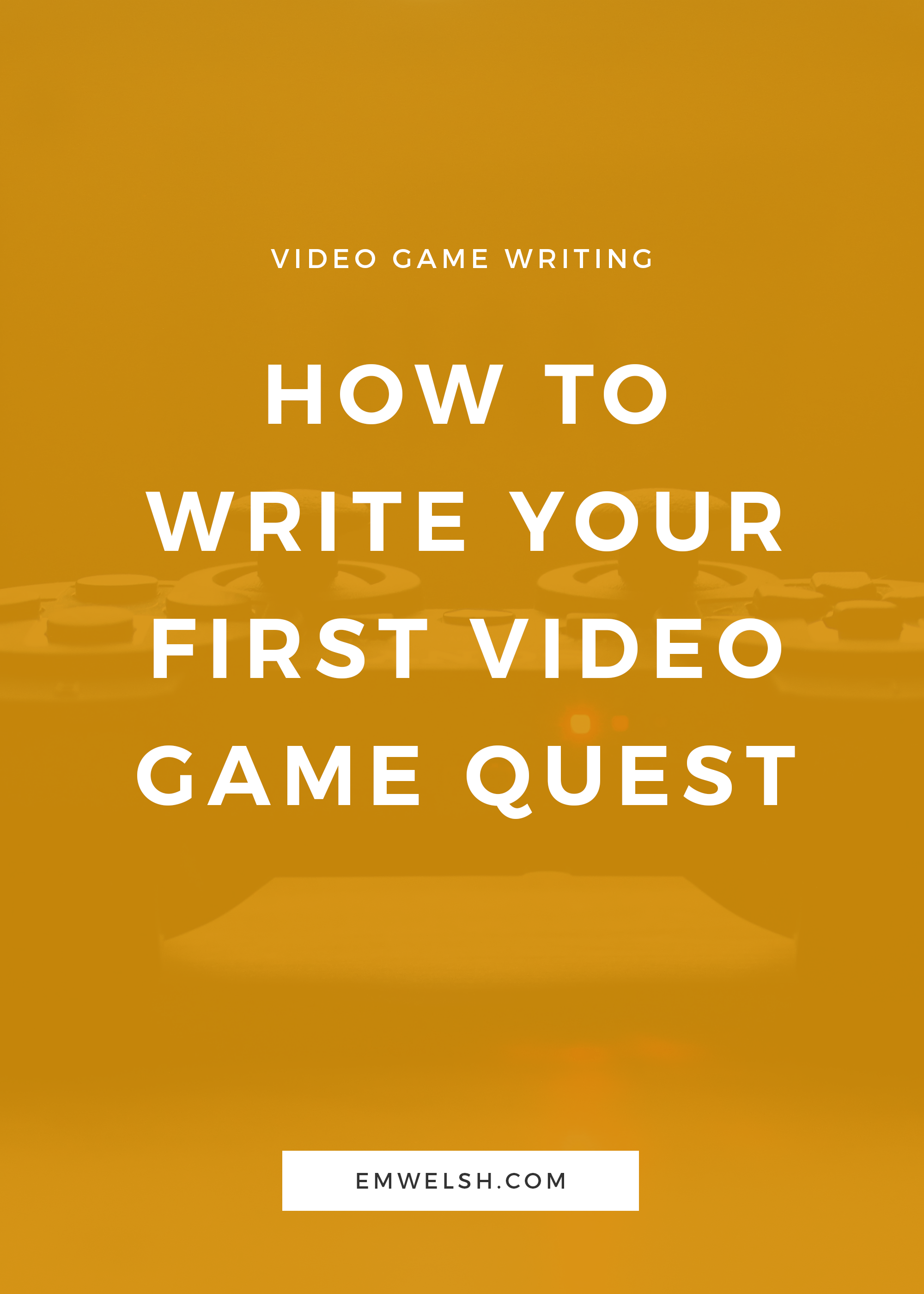How to Write Video Game Characters
/At this point in the series on how to write a video game script, you’ve brainstormed your idea and built out the world, meaning you’re now ready to fill that world with characters.
If you aren’t sure what this is referring to or haven’t yet built out your video game world, be sure to navigate back to the first post in the series using the navigation below:
How to Write Video Game Characters
Step 1. Decide whether your player will be pre-established or be created by the player.
Most stories have a character that was created and that’s it. But in video games, there is a player-character dynamic that mixes up how we perceive our main character. Because of this, main characters are also the storytellers with the players, meaning in addition to creating a character like you would for a book, you must also allow for this character to also have a will of its own, per se. They must be malleable and be created knowing that the player has to believe they are them—even if only slightly—to follow along, something no other storytelling medium requires.
There are two builds of characters in video games—pre-established ones and ones created by the character.
Pre-established characters are ones with a set backstory, look, and behavior. One created by the player is one that’s look, backstory, and behavior is dictated by the player and the tools they are given. (After all, they are only able to use the tools the game gives them.)
So, as you can see, before you can even begin to build your character, you need to decide which of these two it is. Whether your game is third- or first-person doesn’t affect this decision—at least not in terms of a player’s ability to empathize with someone pre-established or someone they helped create.
Instead, what is affects is your players relationship with the character and their dynamic together.
Below are some pros and cons to help you think through your decision if you are unsure:
Pre-Established Characters
Pros: your lead becomes an icon for the game and a memorable character. There is less work in terms of writing—though there is still quite a lot—and it’s easier to write a story with possibility and depth, because you don’t have to juggle so many different possibilities.
Cons: backstory is difficult to explain. Often players have trouble hearing backstory and history that they didn’t experience in the game, thinking “but my character wouldn’t do that.” As a result, writers, too often, rely on amnesia as a crutch so they can explain backstory and behaviors and “who the character is.”
Characters Created by the Player
Pros: players fill in the gaps and create their own backstory, making it easier for them to believe they are the person they are playing as, and it makes for a more personal journey because it feels like it’s the player, not a character, doing everything. Additionally, you don’t need to spend as much time plotting out all the details of your main character.
Cons: you have to write many different variants of your character that your entire can accommodate, giving you more work in every area. Also, if too loose in the freedoms you give the player, you will run into the same cognitive dissonance issue that pre-existing characters run into.
REMEMBER: No matter who your character is, it is the player—not you—that will be living through their actions. For that reason, even if you have an in-depth backstory, you have to convince the player that they too experienced things in the main character’s backstory, which can be tricky. Often this is repaired via dialogue or exposition, but sometimes even that is enough.
It’s also worth noting that you can indeed create a mix of these two character-types. For example, in Horizon Zero Dawn, you play as a pre-established Aloy, but you’re given dialogue options that determine your personality type. Or in Dragon Age 2, you play as Hawk, a character created by the player that has many pre-established traits as well.
It’s all about what works best for you and the players who will experience your story!
Step 2. Give your main character characteristics and a background.
After you’ve decided what type of character players will be playing as, you can then do everything else you would normally do when creating a character for any other storytelling medium.
Keep in mind that how everyone creates their main character is going to be different. For some, that may be curating a board of inspiration, whereas for others that might mean knowing their pet peeves to the things that make them weak.
While some people may say you should know all of these things before you get to work (the history, appearance, and so forth of your characters, I mean), for many writers, traits about your characters are discovered, so how you ideate may alter your approach to creating character.
For tips on how to create characters, check out my guide on how to write complex characters—it works for all types of storytelling!
Now, you might think that if you chose a character that players created, you’re done here and that you don’t need to worry about backstories or behaviors. But that is not the case.
The fact is you still need to give this character a “why”—why they are in this story and why it is so important. And while you may not need to give them a set look and an attitude, but you need to still plot out the why, and then plot out all the different options for who your player can be, all the different ways they can look, and all the different attitudes and personalities your players can choose from.
Step 3. Write out an arc for your character.
After you’ve fleshed out your character, giving them a personality and place in your story, it’s time to map out their arc as it relates to your story. Remember that before this, you should have mapped out the general arc of your story—not your character’s, but the story’s. The reason for this is because often the story’s arc may remain the same, but a character’s can change depending on the player. This way you are giving your character a solid foundation while still allowing for flexibility for your players.
So, write out the arc of your character, and if you have multiple possibilities, write these out as well. Once you’re done, see how it fits into your main story and world. It doesn’t have to fit perfectly, especially given that players are prone to wandering and straying from all story in larger games at times.
Most of all, make sure that if your world allows for exploration, that you make it easy for the player-character to return to the main plot afterwards. This is often done by omitting deadlines and making the journey feel more self-motivated instead driven by external forces, but how you do it is up to you.
Just remember that this arc can easily match up with your story arc, or be completely separate from it. The reason for this is because one arc is dictated by the player, whereas the other is dictated by your story.
Step 4. Establish relationships with other characters.
After you’ve created the arc of your character’s story, you can then start using that arc to establish various relationships—both good and bad—with other characters.
This may require some backtracking later on as you develop side characters and other NPCs for quests, but in general begin to brainstorm different key characters your player will interact with throughout the majority of the story.
Consider the different ways a relationship can go, what it looks like when it goes well and when it goes sour, and how you can still maintain a consistent character regardless of the outcome. This doesn’t mean your main character or side characters won’t change, but that deep down they must maintain core traits that make all options and possibilities believable. Because when these options are believable, so your main character is as well.
Step 5. Fill your world with other characters
How many characters you fill your world will with may vary depending on the story, but you’ll want to start adding in new characters, like NPCs and side characters that are in your “party” to help further build out your character.
How your character (and player) interacts with other characters in the story will shape how they perceive their place in the story, so establishing these other people is equally as important.
If you think about it, people in their day-to-day life define themselves by the people that surround them, so it just as important to flesh out these side characters—if not more—than it is to flesh out the main one. This is especially true given that many players perceive themselves as the main characters and therefore don’t worry as much (usually) whether they are interesting or not.
So, whether it’s one person or three hundred, continue to fill your world out with other characters to interact with your main character.
After you’ve done this, you still have a lot of work to do before you get to writing. Planning is incredibly important in video games, especially in those where you have various outcomes and possibilities. However, if you nail the player-character dynamic and the world, you will set yourself up with a solid foundation for writing a good video game script.












